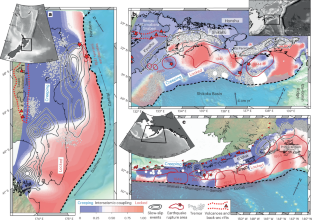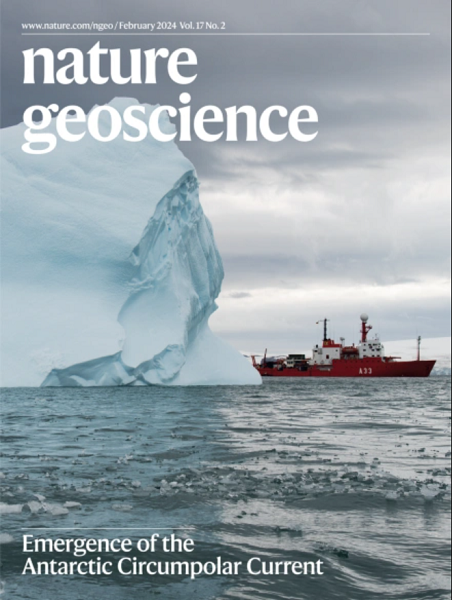Variation in slip behaviour along megathrusts controlled by multiple physical properties
IF 15.7
1区 地球科学
Q1 GEOSCIENCES, MULTIDISCIPLINARY
引用次数: 0
Abstract
Megathrusts, faults at the plate interface in subduction zones, exhibit substantial spatiotemporal variability in their slip behaviour. Many previous attempts to discern the physical controls on their slip behaviour have focused on individual variables, often associated with the physical properties of either the subducting plate (for example, its age and roughness) or the overriding plate (for example, its thickness and rigidity). Such studies, which are often location-specific or focused on single variables, have fuelled contrasting views on the relative importance of various physical properties on megathrust slip behaviour. Here we synthesize observations of the Alaska, Hikurangi and Nankai subduction zones to ascertain the main causes of the well-documented changes in interseismic coupling and earthquake behaviour along their megathrusts. In all three cases, along-trench changes in the distribution of rigid crustal rocks in the forearc, the geometry of the subducting slab and the upper-plate stress state drive considerable variability in the downdip width of the seismogenic zone. The subducting plate is systematically rougher in creeping regions, with fault-zone heterogeneity promoting a mixture of moderate to large earthquakes, near-trench seismicity and slow-slip events. Smoother subducting plate segments (with thicker sediment cover) are more strongly correlated with deep interseismic coupling and great (>Mw 8) earthquakes. In the three regions considered, there is no one dominant variable. Rather, we conclude that several physical properties affecting the dimensions and heterogeneity of megathrusts collectively explain observed along-trench transitions in slip behaviour at these subduction zones, and potentially at many other subduction zones worldwide. Multiple factors, including slab geometry and upper-plate stress state, determine the variation in slip behaviour along most megathrusts, according to a synthesis of observations of the Alaska, Hikurangi and Nankai subduction zones.


由多种物理性质控制的巨型逆冲断层滑动行为的变化
巨型逆冲断层是俯冲带板块界面上的断层,其滑动行为表现出明显的时空变异性。以前许多试图识别其滑动行为的物理控制因素的尝试都集中在单个变量上,这些变量通常与俯冲板块(例如,其年龄和粗糙度)或上覆板块(例如,其厚度和刚性)的物理性质有关。这类研究通常是针对特定位置或集中于单一变量的,它们助长了关于各种物理性质对巨型逆冲滑动行为的相对重要性的不同观点。在这里,我们综合了阿拉斯加、Hikurangi和南开俯冲带的观测资料,以确定地震间耦合和地震行为沿其巨型逆冲带变化的主要原因。在这三种情况下,弧前刚性地壳岩石沿海沟分布的变化、俯冲板块的几何形状和上板块的应力状态驱动了孕震带下倾宽度的显著变化。俯冲板块在爬行区较为粗糙,断裂带的非均质性促进了中大型地震、近沟地震活动和慢滑事件的混合。较光滑的俯冲板块段(沉积物覆盖较厚)与深部震间耦合和大地震(> mw8)的相关性更强。在考虑的三个区域中,没有一个占主导地位的变量。相反,我们得出的结论是,影响巨型逆冲断层的尺寸和非均质性的几种物理性质共同解释了在这些俯冲带以及世界上许多其他俯冲带观察到的沿海沟滑动行为转变。
本文章由计算机程序翻译,如有差异,请以英文原文为准。
求助全文
约1分钟内获得全文
求助全文
来源期刊

Nature Geoscience
地学-地球科学综合
CiteScore
26.70
自引率
1.60%
发文量
187
审稿时长
3.3 months
期刊介绍:
Nature Geoscience is a monthly interdisciplinary journal that gathers top-tier research spanning Earth Sciences and related fields.
The journal covers all geoscience disciplines, including fieldwork, modeling, and theoretical studies.
Topics include atmospheric science, biogeochemistry, climate science, geobiology, geochemistry, geoinformatics, remote sensing, geology, geomagnetism, paleomagnetism, geomorphology, geophysics, glaciology, hydrology, limnology, mineralogy, oceanography, paleontology, paleoclimatology, paleoceanography, petrology, planetary science, seismology, space physics, tectonics, and volcanology.
Nature Geoscience upholds its commitment to publishing significant, high-quality Earth Sciences research through fair, rapid, and rigorous peer review, overseen by a team of full-time professional editors.
 求助内容:
求助内容: 应助结果提醒方式:
应助结果提醒方式:


